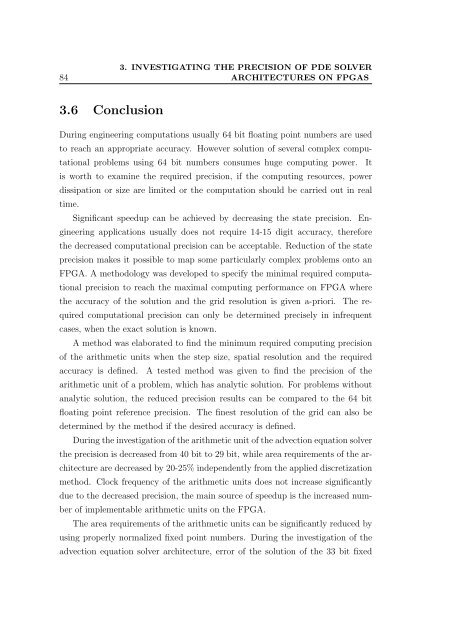PPKE ITK PhD and MPhil Thesis Classes
PPKE ITK PhD and MPhil Thesis Classes
PPKE ITK PhD and MPhil Thesis Classes
Create successful ePaper yourself
Turn your PDF publications into a flip-book with our unique Google optimized e-Paper software.
84<br />
3. INVESTIGATING THE PRECISION OF PDE SOLVER<br />
ARCHITECTURES ON FPGAS<br />
3.6 Conclusion<br />
During engineering computations usually 64 bit floating point numbers are used<br />
to reach an appropriate accuracy. However solution of several complex computational<br />
problems using 64 bit numbers consumes huge computing power. It<br />
is worth to examine the required precision, if the computing resources, power<br />
dissipation or size are limited or the computation should be carried out in real<br />
time.<br />
Significant speedup can be achieved by decreasing the state precision. Engineering<br />
applications usually does not require 14-15 digit accuracy, therefore<br />
the decreased computational precision can be acceptable. Reduction of the state<br />
precision makes it possible to map some particularly complex problems onto an<br />
FPGA. A methodology was developed to specify the minimal required computational<br />
precision to reach the maximal computing performance on FPGA where<br />
the accuracy of the solution <strong>and</strong> the grid resolution is given a-priori. The required<br />
computational precision can only be determined precisely in infrequent<br />
cases, when the exact solution is known.<br />
A method was elaborated to find the minimum required computing precision<br />
of the arithmetic units when the step size, spatial resolution <strong>and</strong> the required<br />
accuracy is defined. A tested method was given to find the precision of the<br />
arithmetic unit of a problem, which has analytic solution. For problems without<br />
analytic solution, the reduced precision results can be compared to the 64 bit<br />
floating point reference precision. The finest resolution of the grid can also be<br />
determined by the method if the desired accuracy is defined.<br />
During the investigation of the arithmetic unit of the advection equation solver<br />
the precision is decreased from 40 bit to 29 bit, while area requirements of the architecture<br />
are decreased by 20-25% independently from the applied discretization<br />
method. Clock frequency of the arithmetic units does not increase significantly<br />
due to the decreased precision, the main source of speedup is the increased number<br />
of implementable arithmetic units on the FPGA.<br />
The area requirements of the arithmetic units can be significantly reduced by<br />
using properly normalized fixed point numbers. During the investigation of the<br />
advection equation solver architecture, error of the solution of the 33 bit fixed






![optika tervezés [Kompatibilitási mód] - Ez itt...](https://img.yumpu.com/45881475/1/190x146/optika-tervezacs-kompatibilitasi-mad-ez-itt.jpg?quality=85)









